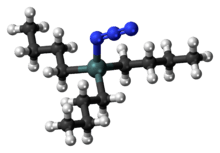Tributyltin azide
 | |
 | |
| Names | |
|---|---|
| IUPAC name
Azido(tributyl)stannane | |
| Other names
Tri-n-butylazidotin; Tributyltin azide; Azidotributyltin; Azidotributyltin(iv); Azidotributylstannane; Nsc179738 | |
| Identifiers | |
| 17846-68-3 | |
| 3D model (Jmol) | Interactive image |
| Abbreviations | TBSnA |
| ECHA InfoCard | 100.133.218 |
| |
| |
| Properties | |
| C12H27N3Sn | |
| Molar mass | 332.08 g·mol−1 |
| Appearance | Colorless to light yellow liquid or white solid |
| Density | 1.212 g/mL |
| Boiling point | 120 °C (248 °F; 393 K) at 0.2 mmHg |
| Reacts | |
| Hazards | |
| R-phrases | R21 R23 R25 R36 R38 R48 R50 R53 |
| S-phrases | S35 S36 S37 S39 S45 S60 S61 |
| Flash point | > 110 °C (230 °F; 383 K) |
| Lethal dose or concentration (LD, LC): | |
| LD50 (median dose) |
400 mg/kg (oral, rat) |
| Except where otherwise noted, data are given for materials in their standard state (at 25 °C [77 °F], 100 kPa). | |
| | |
| Infobox references | |
Tributyltin azide is an organotin compound. It is usually synthesized from tributyltin chloride and sodium azide.
Uses
Tributyltin azide is a reagent used in the synthesis of tetrazolylbenzene compounds. It has been used in pharmaceutical research and production to synthesize tetrazole derivatives, which in turn are used to create angiotensin II receptor antagonists.
In the above synthesis of tetrazole derivatives, tributyltin azide has been replaced by the less toxic trioctyltin azide and organoaluminium azides.[1]
Safety
Lower alkyl tin compounds are generally highly toxic. Tributyltin azide has a penetrating odor, which is readily absorbed by other materials, for example, clothes of workers, reaction vessels or drying machines. Once the vapor is absorbed it is hard to remove. Skin exposure to tributyltin azide causes skin rashes, itching or blisters.[2][3]
References
- ↑ Aureggi, Valentina; Sedelmeier, Gottfried (2007). "1,3-Dipolar Cycloaddition: Click Chemistry for the Synthesis of 5-Substituted Tetrazoles from Organoaluminum Azides and Nitriles". Angewandte Chemie. 119: 8592. doi:10.1002/ange.200701045.
- ↑ Tri-higher alkyl tin azide and its use, United States Patent 5484955
- ↑ Saito, S (1989). "Highly nucleophilic tributyltin azide in oxirane ring cleavage leading to 1,2-azido alcohol". Tetrahedron Letters. 30: 4153. doi:10.1016/S0040-4039(00)99346-8.